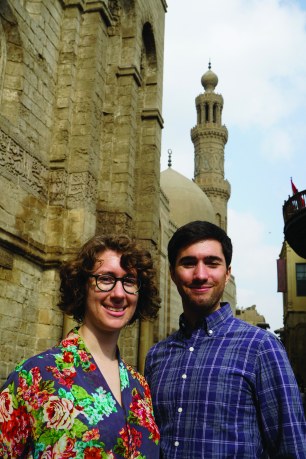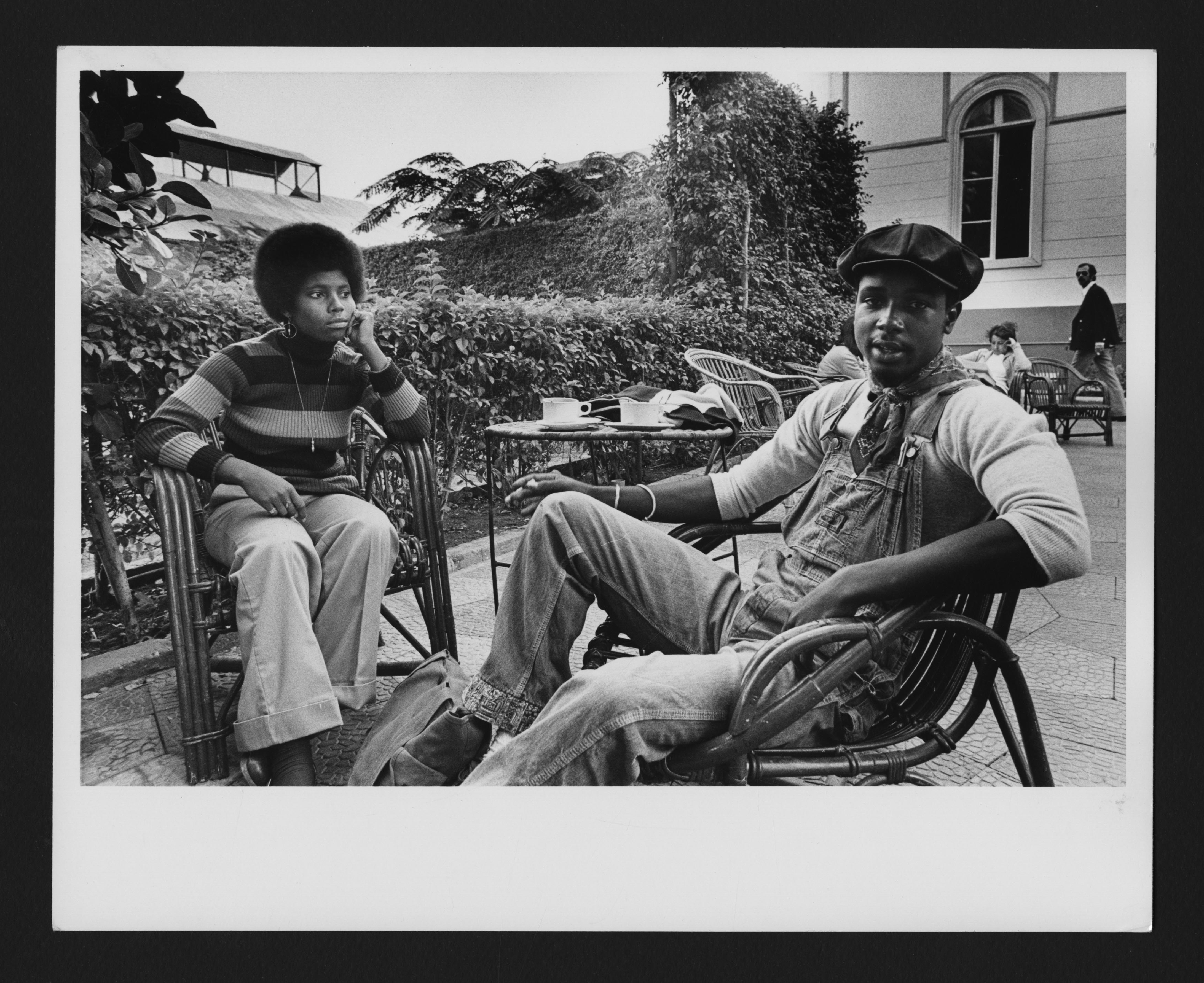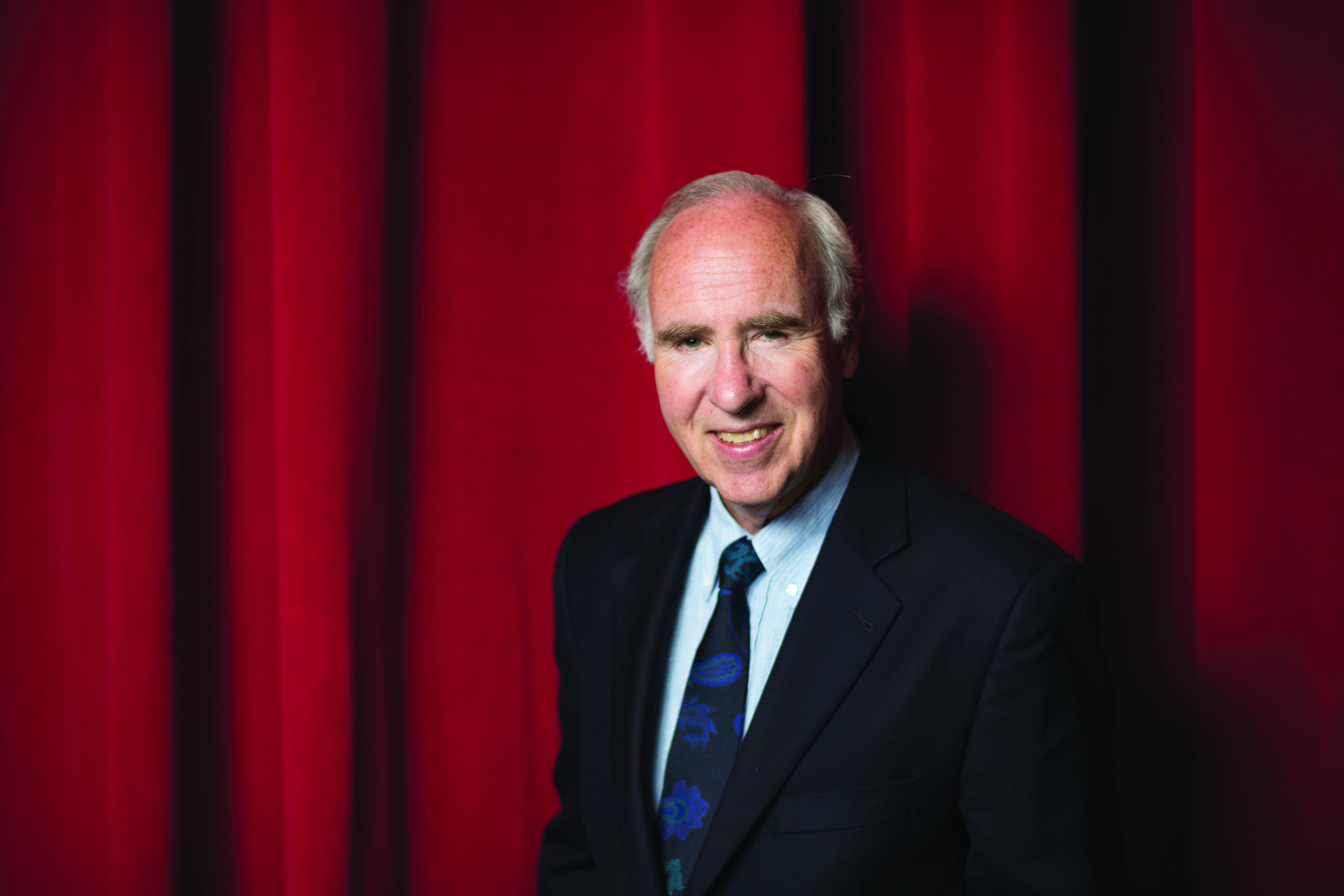Building Skins, Tearing Boundaries
By Ioanna Moriatis | This story appeared in the Fall 2017 edition of AUC Today.
"It was helpful to learn how architects think in other countries. In Egypt, we always have the same idea of what architecture should be like, and we use the same notion with everything we do, but apply it to different buildings. In this case, we got to see different perspectives and learned how to use these perspectives to create a better design."
This is how architecture student Reem Gamil described her international experience as part of the Architectural Design Studio VIII High-Tech class, where AUC students worked collaboratively with their peers from Princeton University in the United States, as well as Roma Tre University in Italy and The French University in Egypt, on developing adaptive, low-cost skins for buildings.
Skins for buildings? "Yes, similar to human skin, it protects, regulates and acts as a sensor, adapting to different environmental conditions like humidity, light and temperature in a sustainable and energy-efficient manner," explained Sherif Abdelmohsen, associate professor of digital media and design computing in the Department of Architecture, who is leading the project on the AUC side.
 Laila Azmi works on the fabrication and assembly of her group's project, The Morphers
Laila Azmi works on the fabrication and assembly of her group's project, The MorphersStudents and faculty members from the partner universities explored innovative, inexpensive and energy-efficient adaptive skins, which envelope buildings to moderate the influence of weather on the interior of a building, thus enabling the design of a zero-carbon built environment. "Current solutions to control the influence of weather on building interiors rely on rigid, intricate and expensive devices, which restrict their wider adoption in low-carbon buildings," said Abdelmohsen. "This project examines the interplay between geometry, morphology, natural material behavior and environmental performance to develop skins that reduce energy consumption."
International Innovation
Abdelmohsen and his main counterparts at Princeton University -- Sigrid Adriaenssens, associate professor of civil and environmental engineering, and Guy Nordenson, professor of architecture and structural engineering -- initiated the project upon receiving a grant from the Bartlett Family Fund for Innovation and International Collaboration, which assists faculty members in their collaborative research with other universities. The Bartlett Family Fund paves the way for partnerships between universities across the globe, opening doors for new, diverse perspectives that enhance research initiatives. "The project had teams from different disciplines working together with the primary goal of deepening the intellectual and scholarly engagement between AUC and Princeton University," said Abdelmohsen.
Increasing international exposure for students, Abdelmohsen and Adriaenssens brought in professors Stefano Gabriele from Roma Tre University and Passaint Massoud from The French University in Egypt to contribute to the research project titled, "Soft Adaptive Skins for Energy-Efficient Architecture." The research group focused on wood, specifically cross-laminated timber, in the design and construction of building skins. Students at both AUC and Princeton worked in groups to design, fabricate and operate adaptive building facades using cross-laminated timber. "This collaboration has been key in the development of innovative ideas and the interdisciplinary nature of our work," reflected Abdelmohsen.
 Moshira Ayad and Lina Mahgoub's dynamic shading device prototype
Moshira Ayad and Lina Mahgoub's dynamic shading device prototypeThe three professors also had the support of their research assistants, Luigi Olivieri, who worked with Gabriele; Veronica Boyce, who worked with Adriaenssens; and Rana El-Dabaa, Aly Magdy and Tasbeh Mokbel, assistants who worked with Abdelmohsen at AUC.
With the support of the Bartlett Family Fund, the team was able to delve into the benefits of international collaboration, meeting in person during two workshops held at AUC and Princeton. Engaging directly with one another added another layer to the project, allowing Abdelmohsen and his counterparts to explore the intricacies of the adaptive skins and their applications.
This international exchange also enabled both teams to examine their technology in differing environments -- a vital advantage in investigating environmental influences on buildings and energy efficiency. "This is especially beneficial since we're not working with something artificial; we're working with wood," said Abdelmohsen. "We wanted to see how wood would behave under different conditions and what we can learn from our arid environment versus their humid environment."
Adriaenssens of Princeton added, "Adaptive facades need to fulfill many performance criteria that belong to different traditional disciplines. They need to filter light, heat and cold. They are architectural form makers. They have to be strong, require little actuation energy, and need to fit in a cultural and architectural context. Our research team included architects and engineers. In addition, a facade in the desert of Egypt needs to perform differently from one in the snowy winters of New Jersey. Therefore, the project lent itself well to an interdisciplinary approach with participants of different geographical backgrounds."
With a host of locations from which to draw inspiration, Abdelmohsen and his team were able to develop ideas to further refine their prototypes. "Our initial idea was inspired by the traditional mashrabiya, which is commonly used as a building skin to act as a sun-shading device," he said. "We took an innovative perspective with this traditional design and attempted to lower cost while reducing energy consumption simultaneously."
A Global, Multidisciplinary Approach
Buildings may deceptively appear restrictive to the eye, seemingly limited in the amount of creativity and flexibility that can alter their material and shape. Abdelmohsen contends, however, that architectural design -- being a multidisciplinary practice -- offers limitless possibilities. "It's really endless in terms of what you can do and the kind of innovation that can come out of it," he asserted.
 Team of instructors at the AUC summer workshop: Aly Magdy, Mohamed Saber, Sherif Abdelmohsen, Tasbeh Mokbel, Luigi Olivieri, Sigrid Adrianessens, Passaint Massoud, Rana El-Dabaa, Veronica Boyce and Gasser Youssef.
Team of instructors at the AUC summer workshop: Aly Magdy, Mohamed Saber, Sherif Abdelmohsen, Tasbeh Mokbel, Luigi Olivieri, Sigrid Adrianessens, Passaint Massoud, Rana El-Dabaa, Veronica Boyce and Gasser Youssef.The Bartlett Family Fund sets in motion projects that encourage this type of interdisciplinary collaboration, offering the resources necessary to bring diverse minds together and eliminating obstacles that restrict innovation. Abdelmohsen and his research assistant first traveled to Princeton for two weeks, joining Adriaenssens as she integrated the workshop within her course for architecture and engineering master's students. Building on the results of the Princeton workshop, Abdelmohsen welcomed Adriaenssens, one of her students and Gabriele's research assistant, Olivieri, to AUC New Cairo for a one-week workshop. The international visitors offered their insights as Abdelmohsen's 30 architecture students worked on building prototypes of adaptive skins. This was incorporated into a design exercise for the six-week summer course during which students designed a hypothetical school of architecture for AUC. "We had Professor Gabriele from Italy on Skype during these workshops, giving the students advice and tracing their progress," noted Abdelmohsen. "Such international collaborations really add value to the student experience."
From Gabriele's end, there was a similar appreciation for the chance to collaborate with international partners. "This was wonderful, from my side, for many reasons," said Gabriele. "Firstly, from a human point of view, professional collaborations are better in the presence of empathy and common purpose, and I found this true in this particular case. Secondly, it is very interesting to match your teaching and research experience with your peers from different countries. This definitely enriches you and your research horizons."
 Preliminary testing by students for multiple wood veneer samples.
Preliminary testing by students for multiple wood veneer samples.It is this deeper engagement that Abdelmohsen is particularly keen on. The workshops invited the student perspective into the mix, opening the floor for more dialogue and a rich flow of ideas. Additionally, the project introduced students to distinguished international professors with varying concentrations and expanded channels of communication for students to connect with peers from around the world.
"We were very happy that we brought experts here to work with students on our research," noted Abdelmohsen. "In person, they were able to quickly and easily point out issues for the students to develop in their designs. We wouldn't get that in a normal studio environment. On the other side, AUC students were able to meet and work with top-notch professors in their fields. They were also able to integrate physics into their work, with Gabriele helping to explain technicalities from another perspective."
Adriaenssens, too, observed the benefits of involving students in impactful research. "Research brings students in touch with their inquisitive nature," she said. "Learning how to ask the right questions, developing methods to finding answers to your questions and questioning the results are key for the development of an open and critical mind. In particular, the inclusion of AUC architecture students, who are design and concept-driven, has the potential to lead to a generation of new inventions. The adaptive facades they designed and prototyped were innovative, efficient and beautiful at the same time."
After the success of this collaboration, Abdelmohsen hopes to continue to involve students in international projects, noting the value of prompting students to work on research that extends beyond the classroom and can influence architectural trends even outside of Egypt. "We want to engage our students in international collaborative initiatives like the Bartlett Family Fund to increase their exposure," said Abdelmohsen. "We benefit from the fact that students also tend to act differently in different settings. They become more engaged and committed in a project like this that can have real impact."



 The founding of CASA at AUC was nothing short of a revolutionary academic move, taking students from rigid classroom-based curricula based on analyzing and translating excerpts in Classical Arabic to reacting to breaking news on the radio, appreciating humor in a comedy, crooning the lyrics of a top hit and chatting with a taxi driver.
The founding of CASA at AUC was nothing short of a revolutionary academic move, taking students from rigid classroom-based curricula based on analyzing and translating excerpts in Classical Arabic to reacting to breaking news on the radio, appreciating humor in a comedy, crooning the lyrics of a top hit and chatting with a taxi driver.
 The CASA curriculum's adaptability to the times has allowed it to be versatile and flexible for its students and alumni, with some going into impoverished areas of Cairo for graduate research or simply laughing at memes regularly emerging from Egyptian social media.
The CASA curriculum's adaptability to the times has allowed it to be versatile and flexible for its students and alumni, with some going into impoverished areas of Cairo for graduate research or simply laughing at memes regularly emerging from Egyptian social media. During the fall semester, CASA fellows are dedicated to strengthening their language skills in general. In the spring semester, the program description states that they are "given the chance to use the skills to tailor the program to their own academic and professional needs." Impressed by CASA's relevance and fruitfulness, Kanbergs believes the best part of the program is providing students this opportunity. "We learn from authentic sources on topics that revolve around our interests," he said.
During the fall semester, CASA fellows are dedicated to strengthening their language skills in general. In the spring semester, the program description states that they are "given the chance to use the skills to tailor the program to their own academic and professional needs." Impressed by CASA's relevance and fruitfulness, Kanbergs believes the best part of the program is providing students this opportunity. "We learn from authentic sources on topics that revolve around our interests," he said. CASA students browse through Arabic books to supplement their studies.
CASA students browse through Arabic books to supplement their studies. CASA students are immersed in Cairo's history, culture and language.
CASA students are immersed in Cairo's history, culture and language. Evelyn A. Early (CASA '71) and Judith Gran (CASA '69) featured in Hawaa magazine in 1970.
Evelyn A. Early (CASA '71) and Judith Gran (CASA '69) featured in Hawaa magazine in 1970. CASA's more than 1,500 alumni also form bonds with each other through the intensive program.
CASA's more than 1,500 alumni also form bonds with each other through the intensive program.


 This fall, the association hosted a roundtable discussion titled "Understanding Cultural Diversity at AUC," where graduate students discussed various topics, breaking down barriers and engaging in critical dialogue about individual perceptions of diversity at the University. "We discussed how diverse we actually are, how we do things differently, how we have distinctive greetings," said Ogwang, who grew up in Uganda and is attending AUC under the African Graduate Fellowship. "We talked about how to bridge the disparities that might exist."
This fall, the association hosted a roundtable discussion titled "Understanding Cultural Diversity at AUC," where graduate students discussed various topics, breaking down barriers and engaging in critical dialogue about individual perceptions of diversity at the University. "We discussed how diverse we actually are, how we do things differently, how we have distinctive greetings," said Ogwang, who grew up in Uganda and is attending AUC under the African Graduate Fellowship. "We talked about how to bridge the disparities that might exist."

 In addition to English, STAR hopes to offer French or German next semester, acknowledging a need within the refugee community for enhanced language education. "Many refugees hope to learn French or German in preparation for resettlement in another country," said Wijtsma, who comes from the Netherlands.
In addition to English, STAR hopes to offer French or German next semester, acknowledging a need within the refugee community for enhanced language education. "Many refugees hope to learn French or German in preparation for resettlement in another country," said Wijtsma, who comes from the Netherlands.







 Through D-Kimia, Egypt's first University spinoff that utilizes research and technologies developed at AUC, Hassan Azzazy and his team of scientists have created novel and affordable solutions for hepatitis C diagnosis, including a fully automated, robotic machine. Performing six primary lab functions to isolate specific RNA or DNA as markers of viral or bacterial infections from a patient's blood, the machine is controlled by a computer to avoid human intervention in handling the highly infectious material. The machine self-sterilizes at the end of the process.
Through D-Kimia, Egypt's first University spinoff that utilizes research and technologies developed at AUC, Hassan Azzazy and his team of scientists have created novel and affordable solutions for hepatitis C diagnosis, including a fully automated, robotic machine. Performing six primary lab functions to isolate specific RNA or DNA as markers of viral or bacterial infections from a patient's blood, the machine is controlled by a computer to avoid human intervention in handling the highly infectious material. The machine self-sterilizes at the end of the process.



 Photo by Mohamed Fahmy.
Photo by Mohamed Fahmy.


 Haynes Mahoney on stage at AUC's first Ramadan Nights event. Photo by Ahmad El-Nemr.
Haynes Mahoney on stage at AUC's first Ramadan Nights event. Photo by Ahmad El-Nemr. Other performers -- including some AUCians -- performed before Ayamna El Helwa. Photo by Ahmad El-Nemr.
Other performers -- including some AUCians -- performed before Ayamna El Helwa. Photo by Ahmad El-Nemr. Ayamna el Helwa with Haynes Mahoney and Rami Imam. Photo by Ahmad El-Nemr.
Ayamna el Helwa with Haynes Mahoney and Rami Imam. Photo by Ahmad El-Nemr.